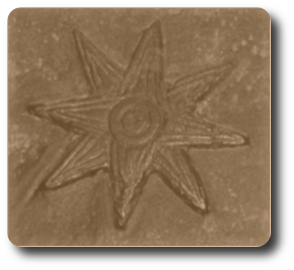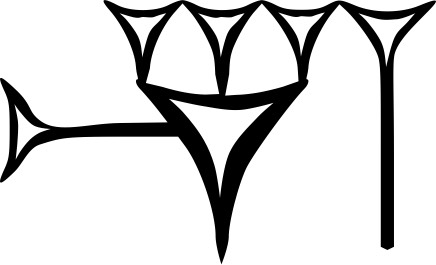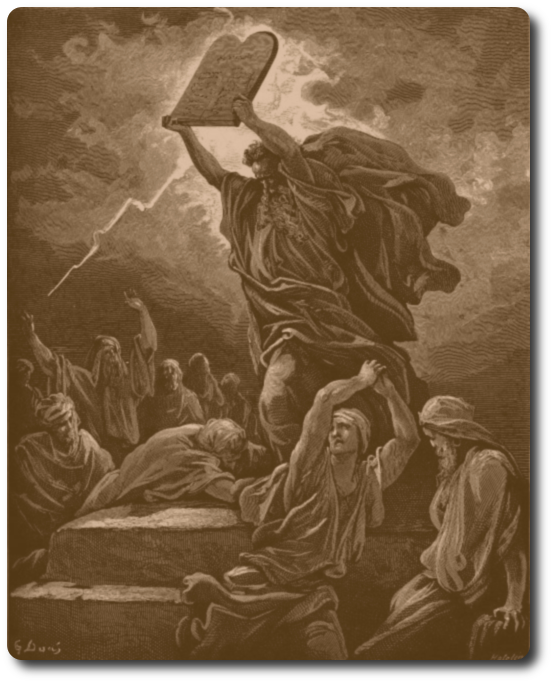Most cultures have myths of the passing of knowledge from the gods (or animals) to men, through trees or trickery. Any prophets in the party must have their mythology tied in some way to the road. Someone has taken knowledge, and someone else is waiting to take it back.
Arthur the king
This is a story of the tablets, too. Arthur’s stone was a tablet of Enki. The sword Arthur drew from the stone was the art of war.
There are tales of a king in the library, named Artur or Artorius. In some of the stories, King Arthur’s stone was a tablet. When Arthur pulled the sword from the stone, he was drawing the art of war from the ancient tablets.
The Mythology of the Road: Enki
Enki is known as the confuser of languages.
Once upon a time there was no snake, there was no scorpion,
There was no hyena, there was no lion,
There was no wild dog, no wolf,
There was no fear, no terror,
Man had no rival.
In those days, the lands of Kish and Thracia,
Harmony-tongued Sumer, the great city of the road,
Quirinus, the land having all that is appropriate,
The land Martu, resting in security,
The stones incircling, the people in unison
To Enlil in one tongue spoke.
Then Enki, the lord of abundance whose commands are trustworthy,
The lord of wisdom, who understands the land,
The leader of the gods,
Endowed with wisdom, the lord of Ishtar
Changed the speech in their mouths, brought contention into it,
Into the speech of man that had been one,
fragmented the stone into nine,
the road into roads unnumbered,
The speech of the cities into vagabond wanderings.
This is from the Sumerian epic, Enmerkar and the Lord of Aratta.
The Mythology of the Road: Ishtar
 She stirs confusion against those who disobey her, spreading carnage and floods. She appears clothed in terrifying radiance. She welcomes conflict and hates waiting. When war looms she walks to meet it, confident, untiring, strapping on her sandals to leave the palace. “If there must be trouble, bring it now, that my children may have peace.”
She stirs confusion against those who disobey her, spreading carnage and floods. She appears clothed in terrifying radiance. She welcomes conflict and hates waiting. When war looms she walks to meet it, confident, untiring, strapping on her sandals to leave the palace. “If there must be trouble, bring it now, that my children may have peace.”
She walks among the downtrodden when the day’s work is done, wearing the garments of the poor. When the servants let the flocks loose, and when cattle and sheep are returned to cow-pen and sheepfold, then the lady Ishtar, like the nameless poor, wears only a single garment. The pearls of a prostitute are around her neck, and she is likely to snatch a man from the tavern for a single memorable night.
In Sumeria she is Inanna; the Greeks name her Astarte. She is the goddess of fertility, love, war, and sex. She rides the storm and rises as Venus at dawn. She is one of three sky gods: Ishtar (Heaven, knowledge), Shamash (Sun, healer), and Sin (Moon, visions, kingship), born of four primordial gods: Anu (Sky, Stars, Demons), Enlil (Wind), Ki (Earth), and Enki (Waters, Abyss, Crafts).
Her temple is called “house of heaven”. The greatest was in Kish, first city after the flood she loosed upon the earth. Nineveh worships her still. Her feast day is the day of the sacred marriage, held at the spring Equinox, and it marks the new year. She is the lady of the sky, daughter of Sin (the moon, who rides a winged bull) and consort to Anu (the sky).
She is the prometheus, the lore-bringer. She tricked Enki into giving her the tablets of civilization, the knowledge of truth, weaving, prostitution, and all crafts and sciences. She plied him with strong beer and left in her sailboat at night while he slept. When he sobered, he sent the regents of Tifá after her boat as it sailed the great ocean; but she escaped the dragons and brought the stone tablets of civilization to the shores of man. Enki’s dragons yet follow down the waters of the abyss. When they reach the city they will retake the tablets.
 Her symbol is an eight-pointed star, or a lion; she is often shown standing on the backs of two lions. Her cuneiform ideogram is a hook-shaped twisted knot of reeds, representing the doorpost to the house of plenty (the storehouse).
Her symbol is an eight-pointed star, or a lion; she is often shown standing on the backs of two lions. Her cuneiform ideogram is a hook-shaped twisted knot of reeds, representing the doorpost to the house of plenty (the storehouse).
She opens doors. She travels to the underworld through many gates; for every gate she exchanges a piece of her clothing. When she returns she retakes her clothing, and must send someone to take her place in the underground. She sends her lover, such as her first love, Tammuz.
The tower of Babylon was built to store the tablets that Ishtar stole from Enki. The tablet of language and the tablet of faith were stolen as they were carried to the top of the finished tower to be hidden away for safekeeping that the city might remain strong.
The Mythology of the Road: Moses
 The tablets of the law are, obviously, a story of Enki. Moses climbed Mount Sinai during a great storm to return with the tablets of the law.
The tablets of the law are, obviously, a story of Enki. Moses climbed Mount Sinai during a great storm to return with the tablets of the law.
Moses and Aaron, Nadab and Abihu, and the seventy elders of Israel went up and saw the Lord. Under his feet was a pavement of sapphire sparkling like the heavens. God lay out a feast for the elders, but Moses was not to eat of food nor drink the water of the mountain.
The Lord said to Moses, “Come to Me on the mountain, and I will give you tablets of stone, and a law, and commandments which I have written, that you may teach them to Israel.”
Moses and Joshua went up the mountain. A storm covered it, and the glory of the Lord flashed on Mount Sinai. For six days the storm covered the mountain, and Moses waited for the commands of the Lord.
On the seventh day the Lord called to Moses from the cloud. Moses entered into the cloud, and was hidden from the world for forty days and forty nights.
“I am the Lord your God, who brought you out of the land of Egypt, out of the house of slavery. You shall not murder. You shall not deal falsely with your neighbor. You shall not covet thy neighbor’s house. You shall bow to none but the God of the Burning Tree, God of the High Mountain, and God of the vast waters. You shall observe the festival of the first fruits of the tree.”
The glory of the Lord looked as a devouring fire atop the mountain. When the Lord finished speaking to Moses, he gave him the two tablets of the law; inscribed front and back by the finger of God.
Moses turned and went down the mountain, carrying the tablets of law before him. As they neared the elders, Joshua cried, “there is the sound of war within the camp!”
Moses replied, “this is not the sound of victory; it is not the sound of defeat. It is singing that I hear. The Lord has told me of this, and He is mighty angry. But I have spake to the Lord and begged his mercy upon the elders of Israel.”
They approached the camp and saw a golden calf, and the elders of Israel dancing around it. His anger burned, and he threw the tablets out of his hands, breaking them to pieces at the foot of the mountain. He took the calf and burned it in the fire; he ground it to powder, scattered it on the water, and he made the Israelites to drink of their iniquity.
The Lord then said to Moses, “carve for me two stone tablets like the ones I gave to you, and I will write on them the words of the law, which you shattered.”
So Moses carved two stone tablets and went up Mount Sinai early in the morning. The Lord came down in his cloud and proclaimed his Name. “The Lord, the Lord, the compassionate and gracious God, slow to anger, abounding in love and faithfulness, forgiving wickedness, rebellion, and sin; yet he does not leave the guilty unpunished. He punished the children and their children for the sin of the fathers to the third and fourth generation.”
Moses walked with the Lord forty days and nights without bread or water. And the Lord inscribed again upon the tablets the word of the law. When Moses came down from the mountain his face was radiant with the light of God, and he veiled his face from the people until he saw the Lord again.
The Israelites made an ark of makaci wood to house the tablets, according to God’s instructions, overlaid with gold inside and out, and upon it a crown of gold, with four golden rings in the corners and again on the sides. Into the rings were staves of makaci wood, covered in gold. The testimony of God was laid therein. Upon the ark they lay a mercy seat of golden cherubim for the Lord to speak. Before it they placed a table of makaci wood, golden laid and crowned, and with four rings of gold in the corners, and golden staves of makaci wood with which to bear the table. Upon the table were dishes of gold, and candlesticks of a trunk and six branches, and flowers, and seven lamps upon the candlestick of seven lamps. And the ark was placed behind ten curtains of linen, blue, purple, and scarlet.
The Mythology of the Road: Oghma
The center of the world is the Great Ash, Cran-Bethadh. Its roots run through all things. When you call forth spirits you are calling on the tree to make itself known to you. All creatures and all things walk its roots and branches.
The Druids venerate Earth, Tree, and Mountain, but the god of the Druids is wisdom. He delivered the knowledge of life and language to the Celts and entrusted it to the Druids for safekeeping. Oghma and two brothers overthrew the Fomorians, their fathers, who lived across the sea. But he is also the fruit of the World Ash Crann Bethadh. To gain the knowledge that man needed to survive, Oghma traveled to the Crann Bethadh at the crossroads of the world, climbed into the tree, and hung there for nine months, and each month the tree showed him one of the paths of the road. When he descended from the tree, he returned to the Celts with language and craft.
His symbol is the Celtic cross that marks the four corners of the world.
The Fomorians yet wait across the sea, biding their time until they can retake the knowledge that is rightfully theirs.
Tane and Maui
When formless Atea divided into Heaven and Earth, the two gods mated, and stayed together for the sake of the children. The children weren’t too happy about this: there wasn’t even enough room between Earth and Sky to walk upright. The offspring of Atea held council and discussed three options. Tawhiri wanted things to stay the same. Tu wanted to kill their parents. Tane’s solution was to push their parents apart. He did so without the consent of his brothers, and a long war raged afterward. Tawhiri and Tangaroa sent great winds from across the sea, and great waves across the lands. Tu stood against Tawhiri, using secret spells, and stole all of Tane’s birds and all of Tangaroa’s fish. Tu sent Tawhiri back to the ocean, and Tane finally vanquished Tu. When he did, he took Tu’s spells and made them his own; and these spells taught men to fish, and to weave, and to build.
During the war, earth was broken into several pieces, and these islands were spread far apart. But with Tane’s new knowledge, people were able to navigate from island to island, and were able to catch fish for food and grow taro to eat.
But still earth and sky long to be together, Tawhiri waits out in the ocean to return with the storm, Tangaroa waits with him, and eats the canoes of Tane’s fishermen with his tentacles, and Tu plots to regain his mako’i spell tablets.
The tablets of Tu are written on mako’i wood from the sacred grove on the great island. They are hidden in Tane’s secret tiki house on a great island of plentiful fruit and trees.
The great tree is Puko, the talking tree.
Possible answers to Divine Guidance
In response to questions about where the gods come from:
“You travel the road with many faiths; some adherents less curious than thee. But you will best have that answered by a friend of the animals, whose worship is the tree.”
“There is no god but hangs from the tree.”
